| |
| |
Photographer,
Location |
Images |
Comments |
|
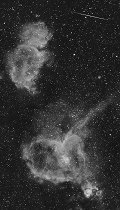
|
Hunter Wilson,
Lexington, Ohio
Aug. 12, 2008 |
#1,
more |
I was imaging the Heart and Soul nebulae in Cassiopeia in the early hours of August 12 - the peak of the Perseid shower and noticed a very bright streak in one of my subexposures. I was imaging in Hydrogen Alpha, so I had a very restrictive filter attached. The Perseid in question must have been a very bright meteor indeed.
|

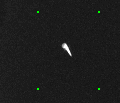
|
Chris Peterson,
Guffey, Colorado, USA
Aug. 12, 2008 |
#1,
#2,
more |
This is a composite video allsky image of 232 meteors collected over four nights. 152 of the meteors were recorded on August 11/12, during the Perseid peak. Also included is a typical fireball video.
|
|
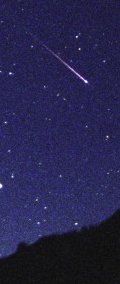
|
Jimmy Westlake,
Stagecoach, Colorado, USA
Aug. 12, 2008 |
#1,
more |
I found this year's Perseid shower to be short on really bright fireballs. Usually, (and I base this on 35 years of Perseid watching) there are at least one or two "shadow-casters" on the night of maximum activity, but I saw none this year. There were dozens of faint-to-moderately-bright ones, though. Sometimes, there would be brief flurries of 6 meteors per minute.
Just before dawn, I captured what turned out to be one of the brightest Perseids of the night. Perseus, the source of all the excitement, is visible at upper left in the photo, Orion has just risen, and the "false dawn," formed by a blend of zodiacal light and Milky Way, brightens the sky. Tracing the trail of the meteor backwards leaves no doubt that this is a progeny of Perseus.
This is a 4 minute piggyback-guided exposure with a Nikon FE2 camera and an f2.8 16 mm fl Nikkor lens taken on Fuji 800 color print film. Time of mid-exposure was 5:05 AM MDT on 8/12/08. I was set up in Stagecoach, Colorado, where the skies were clear and dark after moonset.
|
|
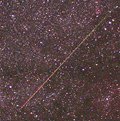
|
Boris Stromar,
Petrova Gora, Croatia
Aug. 12, 2008 |
#1,
more |
There were many
very bright Perseids this morning (12.8.), but only these
two managed to pass in the FOV of my Canon
20D with 24mm lens. |
|
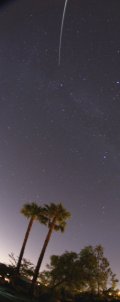
|
Eli Jarra,
Thousand Oaks, CA
Aug. 12, 2008 |
#1 |
Good viewing conditions up until the marine layer rolled in :(
|
|
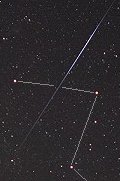
|
Gary A. Becker,
Coopersburg, PA
Aug. 12, 2008 |
#1,
more |
"X" marks the
actual spot of the Perseid radiant on the morning of August
12, 2008. Two Perseids can be seen in the lower right of
the photo in the upper portion of the constellation Perseus.
The "W" represents the star pattern of Cassiopeia. The "blue
meteor" in Cassiopeia is really an Iridium communications
satellite flaring in the sun's early morning light. This
is a composite image created from three 30 second photos,
combined into one.
Photo
details: Canon
40D equatorially mounted, 24mm, Nikkor lens (EFL 38mm),
F/2.8, ASA 800... |
more
images (Aug. 12): ff from
Jeff Greenwald of Laramie, Wyoming; from
Marian Urbanik of Zakopcie, Czech Republic; from
Ugur Ikizler of Kirazli - Bursa / Turkey; from
Krzysztof Polakowski of Gniewowo, Poland; from
Zachary McKinney of Victoria, Virginia; from
Tom Murdic of Holt's Corner, Tennessee; from
Antonio Nouwen of Helmond, The Netherlands; from
David Hodgson of Comox, BC Canada (Vancouver Island);
|
|